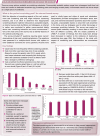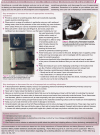Common feline problem behaviors: Destructive scratching
- PMID: 30810089
- PMCID: PMC11373750
- DOI: 10.1177/1098612X19831205
Common feline problem behaviors: Destructive scratching
Abstract
Practical relevance: While scratching is a normal, beneficial behavior for cats, it can create problems when cats scratch objects owners deem as inappropriate. However, if veterinarians make suitable recommendations from the first veterinary visit, owners will be able to implement effective preventive strategies to develop good scratching patterns for life. Educating owners as to why cats scratch, how to guide cats to scratch only on desirable surfaces (ie, a scratching post), which types of scratching posts are preferred by most cats, the benefits of pheromone products, as well as other strategies to avoid destructive scratching, helps to preserve the cat-owner bond and reduces the risk of relinquishment.
Clinical challenges: Clients may not directly ask veterinarians for their assistance regarding their cat's destructive scratching, and may not be aware that anything can be done except for declawing their cat.
Evidence base: Published studies on scratching are limited. Destructive scratching has been documented as a reason for the relinquishment of cats to shelters and the negative effects of declaw surgeries are being increasingly discovered. Among recent scientific publications are studies assessing kitten and cat preferences for scratching substrates, and the use of pheromones to encourage appropriate scratching behavior. This review draws on these studies, among other resources, as well as the authors' personal experiences.
Keywords: Scratching behavior; client education; declaw; normal behaviors; onychectomy.
Conflict of interest statement
TD provides consulting services for Ceva and has performed unrelated research on behalf of the company.
Figures













Similar articles
-
Tools for Managing Feline Problem Behaviors: Pheromone therapy.J Feline Med Surg. 2018 Nov;20(11):1024-1032. doi: 10.1177/1098612X18806759. J Feline Med Surg. 2018. PMID: 30375946 Free PMC article.
-
Owner observations regarding cat scratching behavior: an internet-based survey.J Feline Med Surg. 2016 Oct;18(10):791-7. doi: 10.1177/1098612X15594414. Epub 2015 Jul 15. J Feline Med Surg. 2016. PMID: 26179574 Free PMC article.
-
Cat owners' perceptions of psychoactive medications, supplements and pheromones for the treatment of feline behavior problems.J Feline Med Surg. 2019 Oct;21(10):902-909. doi: 10.1177/1098612X18807783. Epub 2018 Nov 1. J Feline Med Surg. 2019. PMID: 30382770 Free PMC article.
-
Common feline problem behaviours: Owner-directed aggression.J Feline Med Surg. 2019 Mar;21(3):245-255. doi: 10.1177/1098612X19831206. J Feline Med Surg. 2019. PMID: 30798644 Free PMC article. Review.
-
Common feline problem behaviors: Urine spraying.J Feline Med Surg. 2019 Mar;21(3):209-219. doi: 10.1177/1098612X19831203. J Feline Med Surg. 2019. PMID: 30810092 Free PMC article. Review.
Cited by
-
Feline management practices and resource provision in the UK: A questionnaire-based study of 565 caregivers.Vet Rec. 2025 Aug 2;197(3):e5561. doi: 10.1002/vetr.5561. Epub 2025 Jun 7. Vet Rec. 2025. PMID: 40482058 Free PMC article.
-
Unwanted Scratching Behavior in Cats: Influence of Management Strategies and Cat and Owner Characteristics.Animals (Basel). 2022 Sep 24;12(19):2551. doi: 10.3390/ani12192551. Animals (Basel). 2022. PMID: 36230292 Free PMC article.
-
The Effects of Onychectomy (Declawing) on Antebrachial Myology across the Full Body Size Range of Exotic Species of Felidae.Animals (Basel). 2023 Jul 30;13(15):2462. doi: 10.3390/ani13152462. Animals (Basel). 2023. PMID: 37570271 Free PMC article.
-
Surgical and Behavioral Relationships With Welfare.Front Vet Sci. 2020 Aug 14;7:519. doi: 10.3389/fvets.2020.00519. eCollection 2020. Front Vet Sci. 2020. PMID: 32923471 Free PMC article. Review.
-
Development of a Cat Behaviour Issues Assessment Scale (CABIAS) Assessing Problem Behaviours in Cats.Animals (Basel). 2023 Sep 21;13(18):2992. doi: 10.3390/ani13182992. Animals (Basel). 2023. PMID: 37760392 Free PMC article.
References
-
- American Pet Products Association. Pet industry market size & ownership statistics http://www.americanpetproducts.org/press_ industrytrends.asp (2017-2018, accessed April 6, 2018).
-
- Estes R. Cats – family Felidae. In: The behavior guide to African mammals. Berkley, California: University of California, 2012, pp 349-383.
-
- Casey R: Management problem in cats. In Horwitz DF, Mills DS. (eds). BSAVA manual of canine and feline behavioural medicine. 2nd ed. Gloucester: BSAVA, 2009, pp 98-110.
-
- Bradshaw J, Casey RA, Brown SL. The behaviour of the domestic cat. Oxford: CABI, 2012.
Publication types
MeSH terms
Substances
LinkOut - more resources
Full Text Sources
Miscellaneous

